Closing the BUK on MH17? Dutch final report is clearly biased
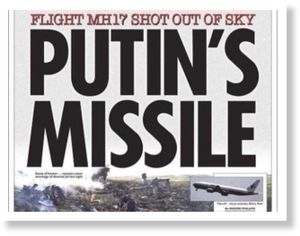 Like so much other propaganda that issues from the official Western channels in recent years, the ‘official’ story about what happened to MH17 has been presented to the public upside down, inside out and backwards.
Like so much other propaganda that issues from the official Western channels in recent years, the ‘official’ story about what happened to MH17 has been presented to the public upside down, inside out and backwards.
Within a day of the crash, Western governments and their subservient press were screaming “Putin’s missile!”, without a shred of hard evidence to back up their hysterical claims. Yet with the recent release of the final report by Dutch authorities that pointed the finger at a “9N314M warhead as carried on a 9M38-series missile and launched by a Buk surface-to-air missile system” as the cause of the destruction of the plane, the response from the same Western powers and press has been shockingly muted.
The reason for this should be clear to all: the real goal behind the shoot down of MH17 was achieved in the immediate days and weeks after the crash.
Soon after Putin’s immediate “trial by Western media”, sanctions were imposed on Russia and the South Stream pipeline agreement between Russia and the EU was cancelled. These and other punitive anti-Russian measures benefited the USA in its long, ultimately futile, war aimed at preventing the emergence of a strong Russia onto the international stage. So, as some suggest about the 9/11 attacks, was the shooting down of MH17 by Ukrainian rebels a stupendously lucky break for Western warmongers in that it came at just the right time to add fuel to its ongoing anti-Russian propaganda campaign? Or is it possible that Western warmongers themselves were responsible for the shooting down of MH17?
Before you decide, there are a few things you should consider.
The Dutch authorities that conducted the investigation were, by default, biased in their approach. This bias stems from the scurrilous and unfounded accusations leveled at Putin in the immediate aftermath of the crash that established an emotionally-charged bogus narrative that a Buk missile must have brought the plane down. From there, the Dutch investigators proceeded to ‘fix the facts around the policy‘ and attempted to show how the plane could have been brought down if a Buk missile was used. Their approach was similar to a police officer deciding that, since the victim was shot by a gun, it must have been a Colt 45.
Bow-tie fragments
Much of the report’s ‘evidence’ to support the Buk missile theory rests on the shape of the fragments that were retrieved from the plane and the bodies of the captain and first officer. The report asserts that no less than 120 metal fragments were found in the body of the first officer with more than 800 puncture holes found in the available wreckage of the cockpit.
“Some” of these fragments allegedly had a “bow tie” shape that is characteristic of the war head on the 9M38M1 Buk missile. The report states that there are 8,000 fragments in a Buk warhead: 4,000 large square-shaped, 2,000 small square-shaped and 2,000 bow-tie shaped. So naturally, you’d expect to find a fairly consistent ratio of 2:1:1 of large squares, small squares and “bow ties”. Below is an image from the report showing 4 fragments it claims were retrieved from MH17.
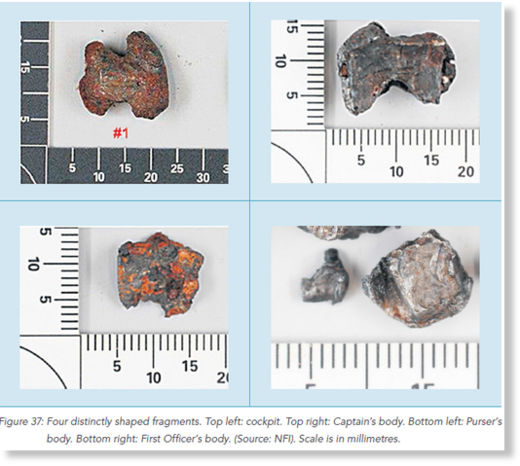
While over 800 metal fragments were retrieved from the bodies of the pilots, passengers, the cockpit and the fuselage, and the report states that “some” were bow-tie shaped, only 20 were specifically used for the report, and of those 20, only two were “bow-tie shaped”. This raises the question of why, in attempting to prove that a Buk missile was used, the report did not specify exactly how many incriminating bow-tie-shaped fragments were found and why, in particular, only 2 of the 20 fragments chosen for specific analysis and inclusion in the report, were actually bow-tie shaped.
But the main problem with the claim of “bow-tie” shaped fragments was highlighted by Russia’s national aviation regulator, Rossaviation, during an October 14th press conference, when its deputy chief said: “There is not a single hole in the plane’s remains that shows a bow-tie pattern“. The point being, how did a few bow-tie-shaped metal fragments get into the bodies of the flight crew without leaving bow-tie-shaped holes in the fuselage? When asked by a Spanish news agency if it was their official position that Dutch investigators contaminated evidence, RossAviation responded: “Absolutely yes. We have proof.”
It’s important to note here that RossAviation does not even accept that a Buk missile of any variety was used. Their statements in response to the Dutch report were simply intended to contest the findings based on investigators’ singular focus on a Buk missile being responsible. The deputy head of RossAviation, Oleg Storchevoy, has stated that their investigation into what really happened to MH17 are continuing.
Also, the Russian manufacturer of the Buk missile system, Almaz-Antey, conducted their own investigations and released their report the day before the DSB released their own final report. They, too, noted the absence of any bow-tie-shaped holes in the wreckage, concluding that the warhead could not have been an 9N314M. Rather, if it was a Buk, it would have to be a B9N314, which does not include bow-tie shrapnel, and which is only used on older-model 9M38 missiles – no longer in use by the Russian military. The Ukrainian military, on the other hand, still uses this older variant. (Though they claim to have sold their stockpile to Georgia.)
And as for those 2 or 3 bow-tie-shaped fragments that are so crucial to the report, it looks like the source of the fragments themselves is a classified military secret of the Dutch Ministry of Defence.
Cockpit crew specifically targeted
The image below from page 140 of the report models the damage pattern to MH17 from a missile similar to a Buk 9M38M1:
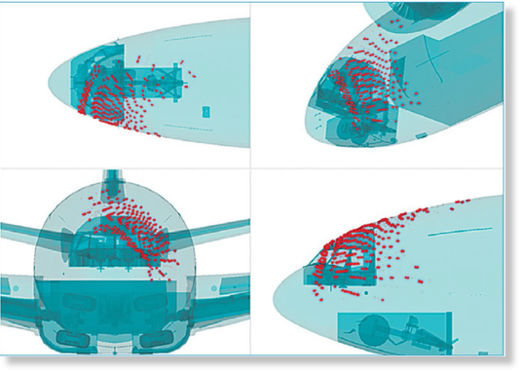
It shows that the missile that targeted MH17 did so with almost “pinpoint” accuracy in that the full destructive power of the warhead was unleashed on the cockpit and the cockpit crew only. It seems reasonable to conclude therefore that those who fired the missile did so with the deliberate intention of instantly killing the pilots and severing the cockpit from the rest of the plane (which is what happened moments after the missile detonated, according to the report). This fact is clearly at odds with the narrative of both the report and even those in Western nations who have accused East Ukrainian rebels of being responsible for the shoot down. There has never been any suggestion, from any quarter, that the rebels intentionally shot down MH17. In fact, how exactly a team operating a Buk missile system, that can easily distinguish commercial aircraft from military, could have “accidentally” shot down MH17 has never been explained.
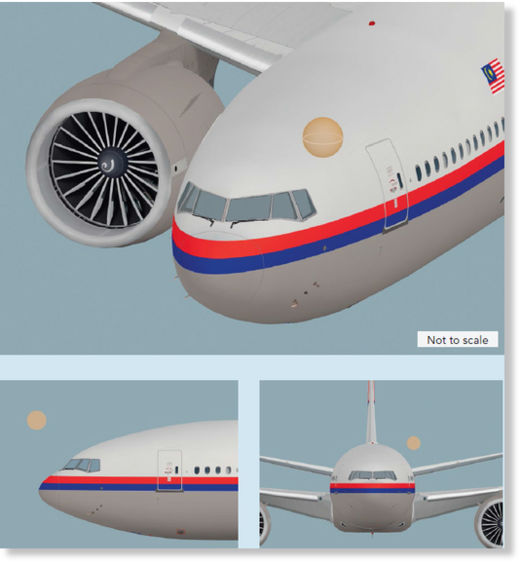
Page 166 of the report concludes:
“The numerous injuries resulting from the perforation of the pre-formed fragments after detonation of the warhead immediately killed the three crew members in the cockpit.
There were no pre-formed fragments found in the bodies of the other occupants. As a result of the impact, they were exposed to extreme and many different interacting factors: abrupt deceleration and acceleration, decompression and associated mist formation, decrease in oxygen level, extreme cold, strong airflow, the aeroplane’s very rapid descent and objects flying around.
As a result, some occupants suffered serious injuries that were probably fatal. In others, the exposures led to reduced awareness of unconsciousness within a very shirt time. It was not possible to ascertain at which moment the occupants died. The impact on the ground was not survivable.”
Further evidence of the highly speculative nature of the evidence presented by the report is seen in the section that deals with the parts of the body of the alleged Buk missile that were found in Ukraine. On page 80 of the report, images of these parts alongside images of the body of a Buk missile are shown. One of the parts is described as a “missile engine nozzle” that was “found in Ukraine”. See below:
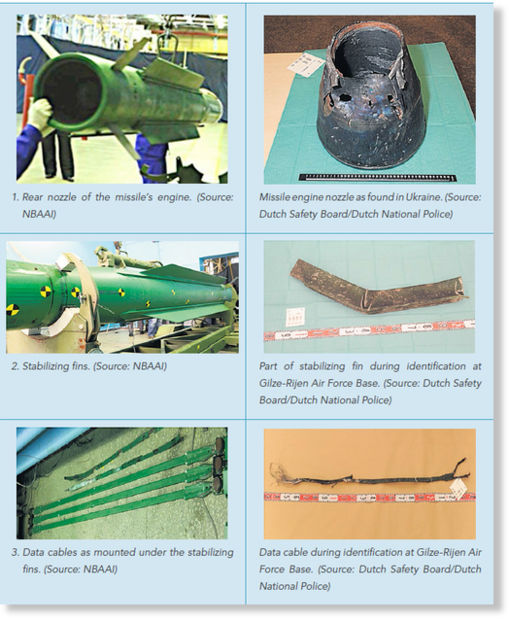
The problem with the cone shaped nozzle as ‘evidence’ that a Buk missile was used is that there are no distinguishing marks on this nozzle, and virtually every missile of similar size to a Buk 9M38M1, including many air-to-air missiles, uses a similar cone-shaped nozzle. As for the “fin” and the “data cable”; correct me if I’m wrong, but most other missiles are composed of such parts, not to mention cars, houses…etc.
In its conclusion on the cause of the in-flight breakup of the MH17, the report states that it was “not caused by an external event such as a lightning strike, the impact of a meteor or the re-entry of space debris”. The report also dismissed, in a qualified way, the possibility that a bomb on board may have detonated:
“While the breakup sequence of the fuselage had some similarities with the failure and break up sequences noted in accidents such as those at Lockerbie in 1988, this accident differed in that the perforation was from the outside. An explosive device inside the pressure hull would not produce the damage patterns found in the wreckage”.
The problem here is that the “damage patterns found in the wreckage” do not exclude a bomb detonating on board the plane. Indeed, the report itself states that after the separation of the cockpit, the rest of the fuselage essentially broke in two. Exactly when and why this happened is “unknown” because “no radar fixes or eyewitness statements on the moment of the in-flight break up were available”. The report’s authors were apparently not interested in the eyewitness statements that do exist and which tell a different story. For example:
Aleksandr, another local who witnessed the plane falling from the sky, was watching TV but when he heard “a roar and two explosions.” He went out to see what was going on.
“[I] saw a spinning plane without a wing with something falling out of it. The plane was shot down,” he told RT. “There were explosions in the sky. And apart from the loud sounds of the plane itself, I heard the buzz which fighter jets make.”
Again, the Dutch authorities appear to have had a pre-formed belief about what the cause of the crash was and sought to make the data fit that belief. In addition, this “final report” is really only a partial report, because approximately 40% of the fuselage was “not recovered”.
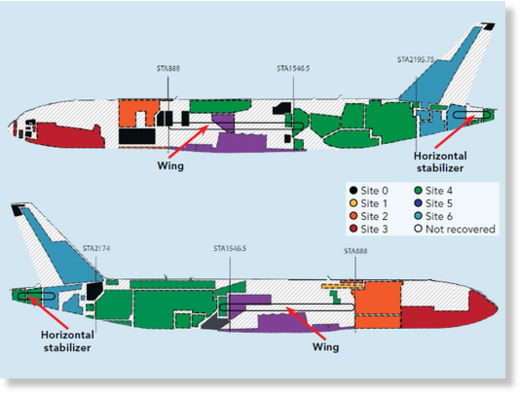
What, no satellite images?
But perhaps the most glaring problem with the Dutch report concerns the use (or lack thereof) of satellite data as part of the investigation. Weather satellite information was used in the report to determine weather conditions on the day of the crash. Voice and data transmission satellite data was used to determine the last communications to and from MH17. Radar data was used to determine the last known position of the plane and imaging satellites were used to determine that some of the wreckage had been “disturbed” on the day of the crash and the day after. What is strange, however, is that arguably the most important alleged satellite data was not even mentioned, let alone used, by Dutch authorities.
Three days after the crash, on July 20, 2014, John Kerry announced on NBC’s Meet the Press that the US State Deptartment “knew to a certainty that within hours of the event, this particular system [Buk SA11] passed through two towns right in the vicinity of the shoot down. We know because we observed it by imagery, that at the moment of the shoot down, we detected a [missile] launch from that area and our trajectory shows that it went to the aircraft”.
Kerry made it very clear that the US government had conclusive and damning evidence about the origin of the missile he claims shot down MH17, yet the final report is extremely ambivalent about the source of the alleged Buk missile, concluding that it is not possible to say from where exactly the missile was fired – ‘rebel’ territory or the territory held by the Ukrainian military. That didn’t stop DSB inquiry chairman Tjibbe Joustra from allegedly telling Dutch journalists that the Buk was launched from rebel-controlled territory. But again, Almaz-Antey concluded that the missile could not have been launched from that location – the blast pattern on the plane would have been different.But still, I really want to know where John Kerry’s “imagery” of the shoot down is.
In early August last year, Malaysian aviation experts told the Malaysian Straits Times newspaper that MH17 could have been brought down by an air-to-air missile and a cannon of the Su-25 fighter that had been “shadowing it”. The suggestion that a Su-25 was involved was first made by Russian military authorities a few days after the crash when they revealed that their radar had detected the presence of a fighter jet in the vicinity of MH17 immediately after it was shot down. The reason the jet was not detected before this moment was because Russian radars were configured to monitor airborne objects in that area that were flying above a certain height. As the jet increased altitude it became visible. This information was reportedly provided to the Dutch authorities but was omitted from the final report.
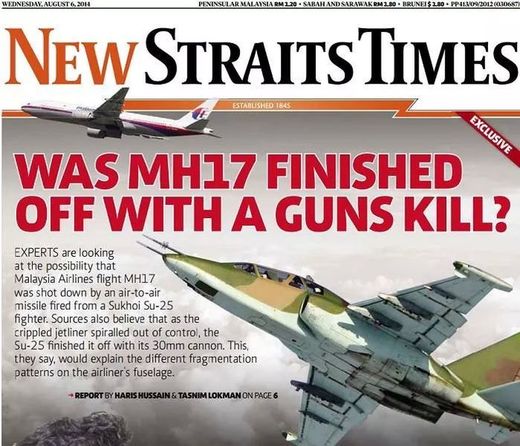
Given the inherent bias in the Dutch report, which leaves open the possibility that the evidence was falsified to support a pre-formed policy of incriminating Russia; the evidence that the cockpit was specifically targeted to kill the flight crew; the unexplained breaking in half of the fuselage; the almost total lack of ‘bow tie’-shaped fragments indicative of a Buk missile; and the clear motive of Western powers, including Dutch authorities, to defame Russia on the international stage in the service of (primarily) Washington’s hysterical drive to thwart Russian economic expansion, I submit that, in the context of understanding the truth of what happened to MH17, the Dutch ‘final report’ isn’t worth the paper on which it was written.
bowtie/I-shape fragments are ca. 1/4 of full warhead shrapnel components.
(1870 bowtie, 1870 filler, 4100 cube fragments)
in addition, the fragments are deformed at the warhead explosion, Almaz-Antey showed slides that about 70% of fragments will be heavily or partially deformed and loose its perfect bowtie or butterfly shape.
also you should consider that the shapes are recognisable only they hit the plane roughly perpendicular.
in Almaz-Antey experiment, they simulate a Shizne direction which resulted many recognisable bowtie shapes because Shizne direction means roughly perpendicular hit angle.
but if the missile launched from more west (but still within the 320km2 area DSB proposed) will mean hits in more smaller angle which results less recognisable holes.
finding more intact shrapnels in debris is a far less hopeful attempt, because most shrapnels went through the cockpit and scattered in a more larger area than the debris field.
If the fragments are so deformed, how can they be determined to be "bow tie" shaped. They could, plausibly, come from another war head. This was a major failing of the report; not looking at other possible war heads and the fragment patter they could cause. Why did the Dutch authorities not do this? Because they were biased from the outset, assuming that their job was to prove it was a "buk".
I didnt say all deformed, but a sensitive percentage. if you check Almaz Antey presentation slides, there are good examples of deformed fragments (pages 25-27): https://www.scribd.com/doc/284722224/Slideshow-va…
they looked at another warheads too, but they thought this type is conclusive due to fragments found in captain body and in cockpit. ofc someone can dispute these findings and assume someone intentionally shot these fragments to body, but such statements needs strong evidence. personally I think it would be very morbid but cant ruled out 100%.
btw, I think the Buk itself is very very plausible. not only DSB, but Almaz-Antey came to same conclusion with explosion test – they rather dispute the Shizne launch direction (and I would agree with that argument).
finally, I dont think the exact type of warhead is so very important. ofc I know that DSB prefer this type because they think it is only in russian inventory. but I think both countries has 9M38M1 warheads in inventory. who could prove or deny that?
we can say the Sukhoi theory now can be ruled out. though Almaz-Antey is a company, in Russia they cant speak anything – we can assume that russian government has the same opinion.
on other hand I think when we talk about Buk, ukrainan army unit cant be excluded. especially if the launch direction is more westward than DSB prefer. not sure though about a real army unit, it could be controlled by some far right-wing militia who mistaken MH17 with a russian reconnaisance plane.
I think the Buk theory is implausible for the simple reason that it is highly unlikely that either the 'rebels' or Ukie forces could have "mistaken" a commercial airliner for a military plane. MH17 had its transponder on, announcing to the world what it was. The Buk system is equipped with identification radar etc. making a "mistake" very unlikely. The entire Buk hypothesis is suspect because it was used to immediately vilify Russia, with no evidence other than that it "must have been the rebels". For me, this was a clear "psy-op" designed to attack Russia – because that was the exact result – and any investigation needs to begin from that premise.
TELAR unit doesnt have IFF. TELAR has IFF or other civil aviation info only if TAR or command unit provides. And the main point is either party did the launch, that was very liikely a lonely TELAR which alone have very limited information and timeframe to lock and fire.
here is a very detailed material for suspecting ukrainen Buk TELAR unit near to Zaroshchenske. http://kremlintroll.nl/?p=569
Have you read this?
http://johnhelmer.net/?p=14340